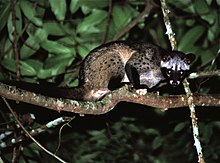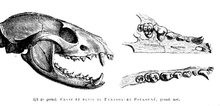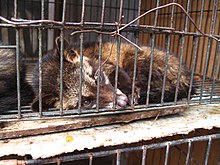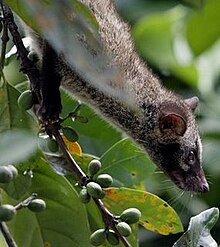
Viverridae is a family of small to medium-sized, feliform mammals. The viverrids comprise 33 species placed in 14 genera. This family was named and first described by John Edward Gray in 1821. Viverrids occur all over Africa, southern Europe, and South and Southeast Asia, across the Wallace Line.

Kopi luwak, also known as civet coffee, is a coffee that consists of partially digested coffee cherries, which have been eaten and defecated by the Asian palm civet. The cherries are fermented as they pass through a civet's intestines, and after being defecated with other fecal matter, they are collected. Asian palm civets are increasingly caught in the wild and traded for this purpose.

The African palm civet, also known as the two-spotted palm civet, is a small feliform mammal widely distributed in sub-Saharan Africa. It is listed as least concern on the IUCN Red List.

The African civet is a large viverrid native to sub-Saharan Africa, where it is considered common and widely distributed in woodlands and secondary forests. It is listed as Least Concern on the IUCN Red List since 2008. In some countries, it is threatened by hunting, and wild-caught individuals are kept for producing civetone for the perfume industry.

Paradoxurus is a genus of three palm civets within the viverrid family that was denominated and first described by Frédéric Cuvier in 1822. The Paradoxurus species have a broad head, a narrow muzzle with a large rhinarium that is deeply sulcate in the middle. Their large ears are rounded at the tip. The tail is nearly as long as the head and body.
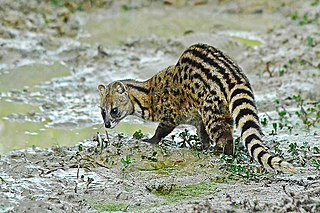
The small Indian civet is a civet native to South and Southeast Asia. It is listed as Least Concern on the IUCN Red List because of its widespread distribution, widespread habitat use and healthy populations living in agricultural and secondary landscapes of many range states.

The banded palm civet, also called the banded civet, is a viverrid native to Indomalaya. They primarily inhabit lowland conifer habitat, which is under threat from encroaching human activity. It is estimated the population of the banded palm civet has decreased by around 30% in just three generations. Banded palm civets are usually approximately the size of a domestic cat; their fur is pale but with dark bands on the back. They are believed to be closely related to Hose's palm civets, which are similar in appearance and distribution.

The small-toothed palm civet, also known as the three-striped palm civet, is a viverrid native to dense forests of Southeast Asia, from the Assam district of India to Indochina and the Malay Peninsula and on Sumatra, Bangka, Java, Borneo, and numerous small nearby islands of Indonesia.

The golden palm civet is a viverrid endemic to Sri Lanka. It is listed as Vulnerable on the IUCN Red List. Its distribution is severely fragmented, and the extent and quality of its habitat in Sri Lanka's hill regions are declining.

The brown palm civet, also called the Jerdon's palm civet, is a viverrid endemic to the Western Ghats of India.

The Malayan civet, also known as the Malay civet and Oriental civet, is a viverrid native to the Malay Peninsula and the islands of Sumatra, Bangka, Borneo, the Riau Archipelago, and the Philippines. It is listed as "Least Concern" by IUCN as it is a relatively widely distributed, appears to be tolerant of degraded habitats, and occurs in a number of protected areas.
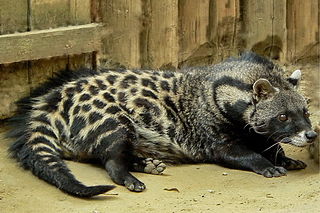
A civet is a small, lean, mostly nocturnal mammal native to tropical Asia and Africa, especially the tropical forests. The term civet applies to over a dozen different species, mostly from the family Viverridae. Most of the species's diversity is found in southeast Asia. Civets do not form a monophyletic group, as they consist only of certain members of the Viverridae, Eupleridae, and Nandiniidae.
The Herveys Range Heritage Tea Rooms are an historical cafe located at the top of the Hervey Range, approximately 32 kilometres (20 mi) north-west of Townsville in North Queensland, Australia. The tea rooms are famous for being the only cafe in Queensland to include kopi luwak coffee on their menu, hailed as the most expensive coffee in the world.

Indonesia was the fourth-largest producer of coffee in the world in 2014. Coffee cultivation in Indonesia began in the late 1600s and early 1700s, in the early Dutch colonial period, and has played an important part in the growth of the country. Indonesia is geographically and climatologically well-suited for coffee plantations, near the equator and with numerous interior mountainous regions on its main islands, creating well-suited microclimates for the growth and production of coffee.

The binturong, also known as the bearcat, is a viverrid native to South and Southeast Asia. It is uncommon in much of its range, and has been assessed as Vulnerable on the IUCN Red List because of a declining population. It is estimated to have declined at least 30% since the mid-1980s. The binturong is the only species in the genus Arctictis.

Hukaung Valley Wildlife Sanctuary is a protected area in northern Myanmar, covering 17,373.57 km2 (6,707.97 sq mi). It was established in 2004 and extended to its present size in 2010. It was initially gazetted in 2004 with an area of 6,371 km2 (2,460 sq mi) in Tanaing Township and extended to Kamaing, Nayun and Kamti Townships. In elevation, it ranges from 125 to 3,435 m in the Hukawng Valley located in Kachin State and Sagaing Region. It harbours evergreen and mixed deciduous forests.
Htamanthi Wildlife Sanctuary is a 2,150.73 km2 (830.40 sq mi) large protected area in northern Myanmar. It was established in 1974 in the Sagaing Region.

Trung Nguyên is a Vietnamese business group involved in the production, processing and distribution of coffee. The firm was founded in 1996 in Buôn Ma Thuột, Đắk Lắk Province by Dang Le Nguyen Vu and Le Hoang Diep Thao upon realizing the potential and opportunities for the development of the coffee industry in opening Vietnam’s economy. Trung Nguyên is the largest domestic coffee brand within Vietnam, and exports its products to more than 60 countries, including major markets such as the United States, the European Union, the United Kingdom, Germany, China, Canada, Russia, Japan, Dubai, Australia, and ASEAN countries, including its international hub in Singapore. The group is composed of several subsidiaries, among them Trung Nguyên Corporation JSC, Trung Nguyên Instant Coffee Company JSC, Trung Nguyên Coffee LLC, G7 Commercial Services Company, Đặng Lê Tourism Company JSC and Trung Nguyên Franchising Company JSC. Its most successful product is G7 instant coffee, which took top domestic position in 2016 and has recorded 200% growth in its export markets. Following a high-profile separation with her husband, in 2016 Le Hoang Diep Thao established an independent spin-off firm in Singapore, Trung Nguyên International, which she used as a springboard for her own coffee chain TNI King Coffee. King Coffee now exports its products to more than 120 countries worldwide.

Tanintharyi Nature Reserve is a strict nature reserve in Myanmar's Tenasserim Hills, covering 1,699.99 km2 (656.37 sq mi). In elevation, it ranges from at an elevation of 20–130 m (66–427 ft). Most of the tropical rain forest is evergreen, interspersed with some grassland. The reserve provides habitat to Asian elephant and Gurney's pitta. It was gazetted in 2005 for the maintenance of natural resources, scientific research and education of local people in surrounding communities.
